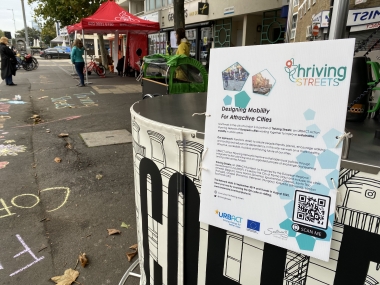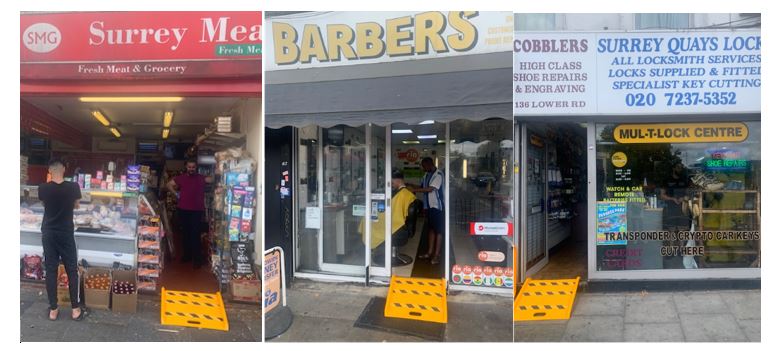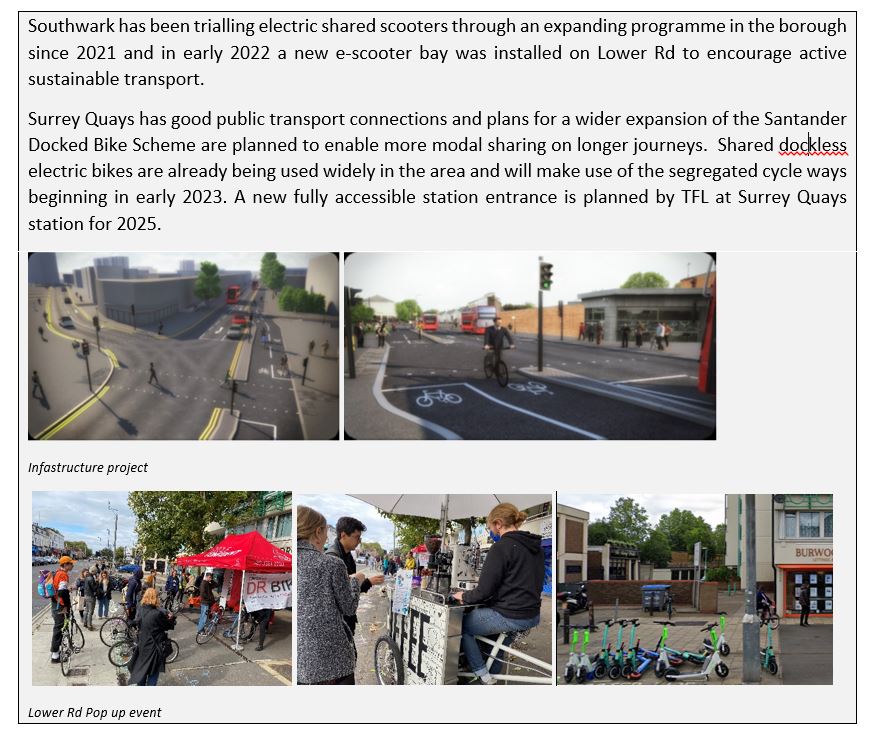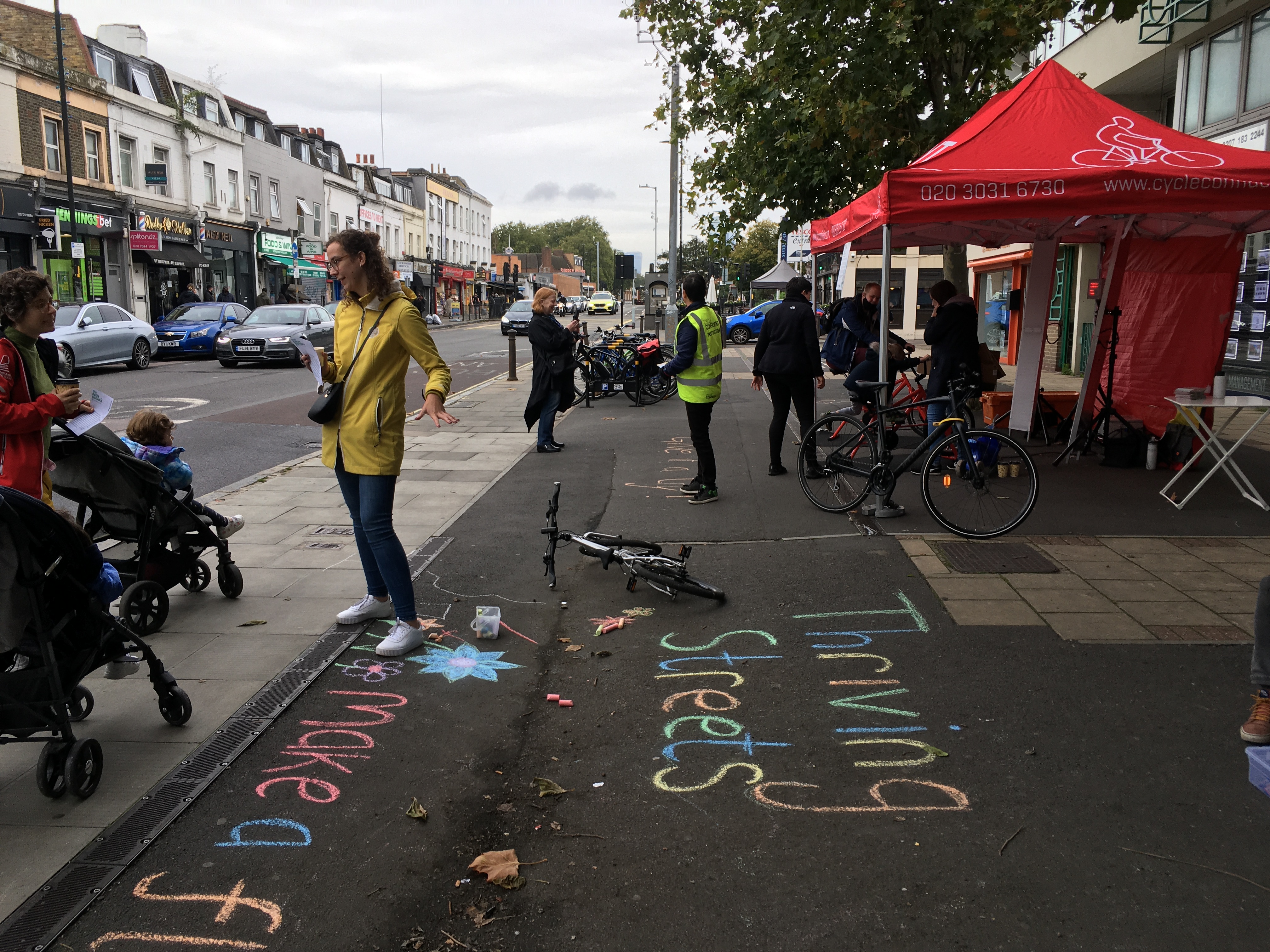Thriving Streets in Southwark – igniting an integrated and accessible high street
Edited on
23 August 2022By Kate Tiernan - project manager Thriving Streets, engagement expert and place maker, Southwark
With high hopes for Lower Rd the Southwark project team started mapping an Action Plan to better integrate this high street and residential area of Surrey Quays in 2019. A diverse parade of shop frontages face the Osprey Housing Estate separated by a busy artillery road. Our vision was to gather local business owners to share expertise on the area with us, through an inclusive and collaborative process. Potential points of growth and conflict had been previously identified through some small scale regeneration work in 2017.

Our vision for this lively community was in utilising shared public space to engage people in creating a place where everyone feels safe from injury and crime at any time of the day. Local businesses that are easily accessible to all and thrive where people can find places to sit and socialise nearby. Activities such as community planting with PNK Garden included everyone, from the young to the elderly and where local history, culture and art are celebrated.
Dialogue with businesses was ongoing in our attempt to gather the local parade of shops, encourage modal shift, improve road safety and accessibility whilst activating underused and overlooked public space. The small scale actions took significant early engagement and planning largely due to the delays and impacts of Covid-19 and limitations this generated. Due in part to this we revised our initial plans for small scale actions to be more iterative and scaled back. The temporary intervention planned for 2020 – 2021 wasn’t any longer feasible due to social distancing restrictions and policy. There was a subsequent review of the aspirations with amended actions communicated.
Southwark is home to 320,000 people and by 2031 its population might increase by 20% with rich diversity and just over half (51%) of the population of white ethnicity compared to 84% nationally, 28% black 10% Asian and 8% mixed and over 120 languages. 52% of adults and 21% of young have mobility impairment and 45% of 10-11 years old and 50% of adults were considered as being overweight. The main areas of development in Southwark will bring about 27,000 new homes and 26,000 new jobs 40% of households own a car.
Surrey Quays where Lower Rd is located in a densely populated district in the 20th century belt of London with 80.000 inhabitants. The areas is dominated by dense often fast moving traffic moving through the area East to West, flanked by the river Thames to the North. A popular route for cycling and walking. Some of the side streets are one way where the temporary intervention was planned to take place. The project team decided to relocate the on street event to a wide footway that during the week is populated with motor bikes to promote and encourage alternative uses.
On Sunday 17th October we hosted an event on the Lower Road engaging residents and businesses again in the project. We had acoustic music, chalk drawing, free bike maintenance, free bike powered coffee from Vello Presso, seed bomb making with PNK Gardens and bike games from Cycle Confident as well as free cycle training. The engagement with the local community was very positive with over 25 bikes repaired and 45+ conversations.
People were happy to see the space more alive and that there was something to do and a reason to stop. Children enjoyed the chalk drawings and the bike games with multiple requests for regular activation of the space. This small scale activation was scaled back from the initial larger vision (pre Covid) of a pop up greening market.
Our action plan included:
- Construction of temporary cycle lanes.
- Detail design and implementation a permanent scheme improve the infrastructure for active travel and safety.
- Controlled Parking Zone.
- Transport for London Cycle hire scheme to be extended to the area.
- Trial installation and monitoring of accessibility ramps.
- Promote the heritage and history of businesses with better signage.
- Feasibility study for reopening of an adventure playground.
- Engagement with local community gardens.
- Explore feasibility of regular market on Cope St involving the community garden and local businesses and potential public art installations.
Collectively and individually these ensure a better environment for all by improving quality of life and strengthening community cohesion. Designing for one specific group with needs by applying a social model approach is likely to benefit other groups. A place is greater than its visible assets and is composed of multiple layers; social, commercial, creative and relational transactions in constant dialogue. Never silent, or finished. A good place is an evolving chorus.

One temporary intervention was an experiment to reclaim underused public space otherwise dominated by cars or motorbikes to be more inclusive, playful and accessible while encouraging pedestrian friendly spaces.

The temporary intervention of yellow ramps was quite successful in the uptake from shops with eight participating including the barbers, cobblers, vet, pub and butchers but with delays to supply they haven’t been in long enough yet to gauge the impact. The community event we hosted as an intervention and trial of a Sunday market was largely a great success, but wasn’t without challenge afterwards. A local shop who we had engaged with but historically display motorbikes on the footway and don’t perceive this to be public space wasn’t supportive. Should this event become regular there would be opportunities to integrate more with the businesses and grow it into a market.
Generosity is crucial to maintain dialogue with local residents and retailers, and engage them meaningfully to contribute to the area action plan. Although we put in significant time and energy speaking with and visiting businesses on multiple occasions it was a challenge to reach high levels of attendance when gathering as a group. With an ongoing iterative approach to our collaborations we were able to adopt an agile way of working.

The conversation started with Thriving Streets in Lower Rd and was interrupted by the corona pandemic, but also by changes in the team due to an internal restructure and change to staffing resource. Since Spring 2022 the team changed and progress was paused. Summer 2022 work restarted on the action plans delivery in the Lower Rd area. Running inclusive drop in events, engaging residents and businesses with aspirations of what they hope the street could be in the future. The team had limited uptake from local businesses through the online survey, with fruitful face to face conversations.
We discovered that many residents and businesses were keen to see the continued activation of dormant and underused public spaces such as the footway we repurposed temporarily with a pop up event. This would give opportunity for greater integration with the community divided by a busy road and a place of connection with green space, planting and market activity.
We have organised an informal gathering in September 2022 at a local coffee shop on Lower Rd that are actively engaged in greening in the Lower Rd area using the wide footway space nearby. This event is an opportunity for us to communicate the last phase of Thriving Streets and signpost about the upcoming works with a temporary segregated cycle way whilst the permanent works progress. People will be encouraged to test out the electric scooters nearby if they haven’t already and we can give help installing applications on their smartphone to do this. The final step in the growth of Lower Rd we hope to be an ongoing forum gathering independently of our involvement to work together as a community applying the learnings from participating in Thriving Streets.

Submitted by Francesca Blamonti on
